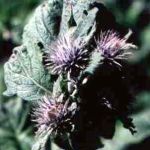| Common Name: |
Kuth |
| Other Names: |
Costus |
| Genus |
Saussurea |
| Botanical Name: |
Saussurea costus syn. S. lappa |
| Family: |
Asteraceae |
| Native Location: |
Himalayas. |
| Cultivation |
Moist soil in sun or partial shade. |
| Propagation |
By seed sown when ripe; by division in spring. |
| Harvest |
Roots are lifted in autumn and spring, and dried for use in decoctions, liquid extracts, and powders, or processed for oil extraction. |
| Height: |
2-3m (6-10ft) |
| Width: |
1m (3ft) |
| Hardiness |
Z10 |
| Parts Used: |
Roots (mu xiang), oil |
| Properties |
A bitter, pungent, warming herb that relaxes spasms, lowers blood pressure, relieves pain, and has anti-bacterial effects. It regulates spleen and stomach energy. |
| Medicinal Uses: |
Internally for abdominal distension and pain, chest pains due to liver problems, and jaundice, gall bladder pain, constipations associated with energy stagnation, and asthma. Used in Ayurvedic medicine for digestive problems, coughs, asthma, cholera, and as an alterative in skin diseases and rheumatism. |
| Culinary Uses: |
Roots are sometimes used for flavoring. |
| Economic Uses: |
Oil is used in commercial food flavoring; also used in perfumery. |
| Bibliography: |
Encyclopedia of Herbs by Deni Bown Copyright © 1995, 2001 Dorling Kindersley Limited. pp 362-363 |
